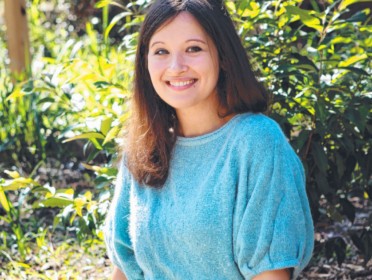
“For as long as I can remember I have seen letters and numbers in colour. ‘A’ has always been red, ‘O’ is white, ‘K’ is blue, and ‘L’ and ‘R’ are green, as are three and seven. The colours I see never change for any given letter or number. Some letters and numbers appear as darker hues or just shades, like ‘E’, which is a dark, blackish shade.
“I realised I was different in 2005, when I was 23 and working as a tutor at a centre for youth with learning, physical and mental disabilities.
“I was reading about how to work with autistic children and the article suggested asking them to associate a colour with a number. ‘Doesn’t everyone already see their numbers in colours?’ I thought. ‘Isn’t seven green for everyone?’ I asked around to see if anyone else saw their letters and numbers this way and found that no-one did. So I looked up the phrase ‘seeing letters in colour’ online and the term ‘synaesthesia’ came up in the results.
“I started researching the condition and found that as you’re forming, the synapses in between your senses can crosswire so you get people who have a blending of their senses, where they’re seeing things in their mind’s eye.
“Research also predicted that the condition runs in families, so I started asking others about it and I found my sister has the same form I do. I will ask people who I think or know are creative if they are the same, because I starting suspecting that people who are writers, photographers and artists have the ability in some way too, and a lot of the time I’m right.
Creative spark
“Synaesthesia doesn’t really affect me in my day-to-day life, but I have always wondered if I developed my creative interests because writing and reading took on an extra facet with the words appearing to me as colours. Research also pointed to this area, as many highly creative people in history are suspected of having synaesthesia, like Lolita author Vladimir Nabokov and composer Franz Liszt.
“It’s made things interesting because if I’m trying to remember a name or number I can just use the colour to jog my memory. I’ll grapple with remembering a name, but know it ‘looks red’ and that will eventually help me determine it. Or I’ll remember the first three digits of a number are red, blue and green, and sometimes that leads me to then be able to remember the number.
“You hear people say, ‘I know this number has a seven in it’ and I’ll say, ‘I know this number has green in it’.
Words are more fun
“My friends always say I have a great memory, which I think is partially due to synaesthesia.
I remember birthdays and names quite well in addition to song lyrics. I’ve also always been a very good speller and was drawn to writing very early in life. I think words in general have always been extra fun for me because of the colour factor.
“The question I’m most often asked is how does it affect my reading? People liken it to a hallucination and ask if letters jump out in different colours on the page, but it’s not like that.
I can still sit down and read a book and not be constantly thinking, ‘Wow, this word has green and blue in it’. When I see letters and numbers already in colour I accept them in the colour they’re in with my visual sense. It’s more in my mind’s eye that I see ‘my’ colours for each letter or number, like when I think of words, names or phone numbers.
A colourful life
“When I tell people about my condition, most of the time they are positive and think it’s really cool, but every now and then I get a cynical person who says, ‘You’re crazy, that can’t be true’ and flat out won’t believe me. But I’ve viewed numbers and letters this way since I was a child, to the point that I thought everyone saw things the same way.
“I do like being a synaesthete as I think it’s helped foster one of my greatest passions in life: writing. I like to think it’s helped my overall creativity as well. Plus it’s just fun literally having colour in my life on a daily basis.”
What is synaesthesia?
The cognitive phenomenon of synaesthesia is often described as a mixing of the senses where the stimulation of one sense will produce an additional sensory experience. A sound may elicit a taste or odour, colours may be associated with letters or numbers, or a day of the week may have a personality.
It is believed to occur in between one in 500 and one in 1000 people.
Source: bodyandSoul
 We are sharing information for knowledge. Presented by. SocialDiary.Net
We are sharing information for knowledge. Presented by. SocialDiary.Net



